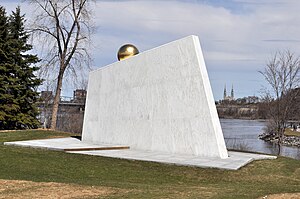
The Royal Canadian Navy is the naval force of Canada. The navy is one of three environmental commands within the Canadian Armed Forces. As of February 2024, the RCN operates 12 Halifax-class frigates, 12 Kingston-class coastal defence vessels, 4 Victoria-class submarines, 4 Harry DeWolf-class offshore patrol vessels, 8 Orca-class patrol vessels, and several auxiliary vessels. The RCN consists of 8,400 Regular Force and 4,100 Primary Reserve sailors, supported by 3,800 civilians. Vice-Admiral Angus Topshee is the commander of the Royal Canadian Navy and chief of the Naval Staff.
The history of the Royal Canadian Navy goes back to 1910, when the naval force was created as the Naval Service of Canada and renamed a year later by King George V. The Royal Canadian Navy (RCN) is one of the three environmental commands of the Canadian Forces. Over the course of its history, the RCN has played a role in the First World War, contributed significantly to the Battle of the Atlantic during the Second World War, and was a part of NATO's force buildup during the Cold War. In 1968, the RCN was amalgamated with the Canadian Army and the Royal Canadian Air Force to form what is today the unified Canadian Armed Forces. The naval force was known as Maritime Command until 2011, when the environmental command was renamed as the Royal Canadian Navy.
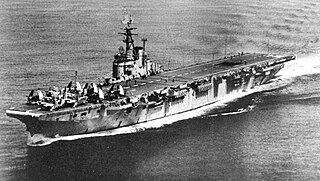
HMCS Magnificent was a Majestic-class light aircraft carrier that served the Royal Canadian Navy from 1948–1957. Initially ordered by the Royal Navy during World War II, the Royal Canadian Navy acquired the Magnificent while waiting for another aircraft carrier to be completed to their needs and it entered service in 1948 replacing in service HMCS Warrior which had been loaned for two years by the RN.
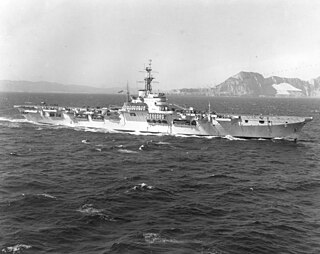
HMS Warrior was a Colossus-class light aircraft carrier which was ordered in 1942 by the British Royal Navy during World War II. Construction was finished in 1945 and upon completion, the aircraft carrier was loaned to the Royal Canadian Navy from 1946 to 1948 as HMCS Warrior. Warrior was returned to the Royal Navy in 1948 and entered service with the British. While in service with the Royal Navy, Warrior was modernised twice, including the installation of an angled flight deck in 1956. In 1948–1949, the ship was used in aircraft landing experiments and fitted with a rubber flight deck and in 1957, was used as the headquarters ship during nuclear testing at Christmas Island. In 1958, the vessel was sold to the Argentine Navy and entered Argentine service in 1959 as ARA Independencia. The aircraft carrier remained in service until 1970 when Independencia was placed in reserve. The following year, the ship was sold for scrap.

The National Capital Commission is the Crown corporation responsible for development, urban planning, and conservation in Canada's Capital Region, including administering most lands and buildings owned by the Government of Canada in the region.
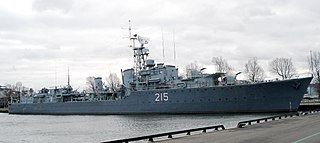
HMCS Haida is a Tribal-class destroyer that served in the Royal Canadian Navy (RCN) from 1943 to 1963, participating in World War II and the Korean War. She was named after the Haida people.

HMS Uganda was a Second World War-era Fiji-class light cruiser launched in 1941. She served in the Royal Navy during 1943 and 1944, including operations in the Mediterranean, and was transferred to the Royal Canadian Navy as HMCS Uganda in October 1944. She served in the Pacific theatre in 1945 and was put into reserve in 1947. When she was reactivated for the Korean War in 1952 she was renamed HMCS Quebec. She was decommissioned for the last time in 1956 and scrapped in Japan in 1961.

The River class was a class of 151 frigates launched between 1941 and 1944 for use as anti-submarine convoy escorts in the North Atlantic. The majority served with the Royal Navy and Royal Canadian Navy (RCN), with some serving in the other Allied navies: the Royal Australian Navy (RAN), the Free French Naval Forces, the Royal Netherlands Navy and, post-war, the South African Navy.

Britannia is a group of neighbourhoods in Bay Ward in the west end of Ottawa, Ontario, Canada. It is located on the Ottawa River across from Aylmer, Quebec, adjacent to its namesake, Britannia Bay, north of Richmond Road, west of the Kichi Zibi Mikan and east of Boyce Avenue. The total population of this area was 6,692 as of the 2016 census. The area constituted a municipal ward from 1973 to 1994.
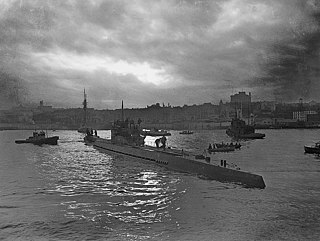
The Battle of the St. Lawrence involved marine and anti-submarine actions throughout the lower St. Lawrence River and the entire Gulf of Saint Lawrence, Strait of Belle Isle, Anticosti Island and Cabot Strait from May–October 1942, September 1943, and again in October–November 1944. During this time, German U-boats sank over 20 merchant ships and four Canadian warships. There were several near-shore actions involving the drop of German spies, or the attempted pickup of escaping prisoners of war. Despite the 23 ships lost, this battle marked a strategic victory for Canadian forces as ultimately they managed to disrupt U-boat activity, protect Canadian and Allied convoys, and intercept all attempted shore operations. This marked the first time that a foreign power had inflicted casualties in Canadian inland waters since the US incursions in the War of 1812.

The St. Laurent-class destroyer was a class of destroyer escorts that served the Royal Canadian Navy and later the Canadian Forces from the mid-1950s to the mid-1990s.

HMCS Crescent was a C-class destroyer that was built for the Royal Navy but was transferred before completion and saw active service with the Royal Canadian Navy. She was one of 32 destroyers of that class built between 1943 and 1945 as part of the War Emergency Programme.
HMCS Ottawa was a St. Laurent-class destroyer that served in the Royal Canadian Navy and later the Canadian Forces from 1956 to 1992. Ottawa was the first bilingual ship to serve in the Canadian navy.

HMCS Summerside was a Flower-class corvette that served the Royal Canadian Navy during the Second World War. She served in several naval theatres of the war. She was named for Summerside, Prince Edward Island. Following the end of the war, the ship was sold for scrap and broken up.

HMCS Beacon Hill was a River-class frigate that served in the Royal Canadian Navy (RCN) as an ocean convoy escort during the Second World War. She fought primarily in the Battle of the Atlantic. In 1954 she was converted to a Prestonian-class frigate and served until 1957. She was named for Victoria, British Columbia, but because HMS Victorious was in service with the Royal Navy, the RCN, in an effort to avoid confusion, chose to honour the city by choosing another name associated with it.

HMCS Cape Breton was a River-class frigate that served the Royal Canadian Navy (RCN) during the Second World War. She served primarily as a convoy escort in the Battle of the Atlantic during the war. She was named for Cape Breton Island in Nova Scotia. She was the first to carry her name, HMCS Cape Breton was the second.

HMCS Swansea was a Canadian River-class frigate that was the most successful U-boat hunter in the Royal Canadian Navy during the Second World War, having a hand in the destruction of four of them. She saw service in the Battle of the Atlantic from 1943 to 1945. Following the war she was refit as a Prestonian-class frigate. She is named for Swansea, Ontario.
HMCS Buckingham was a River-class frigate that served with the Royal Canadian Navy during the Second World War and as a Prestonian-class frigate from 1954–1965. She was named for Buckingham, Quebec. She is considered a significant part of Canadian naval history as used for some early trials of helicopter landings on smaller escort vessels. This led to the development of the future helicopter carrying destroyers.

HMCS LaSalle was a River-class frigate that served with the Royal Canadian Navy during the Second World War. She served primarily as a convoy escort in the Battle of the Atlantic and in the Battle of the St. Lawrence. She was named for LaSalle, Quebec.

MV Asterix is a Canadian commercial container ship. It was purchased by Federal Fleet Services as part of Project Resolve, and was later converted into a supply ship for the Royal Canadian Navy (RCN). She is intended to act as an interim replacement between the out of service Protecteur-class replenishment oiler and the future Protecteur-class auxiliary vessel. Originally launched in Germany in 2010 as Cynthia, the ship was converted and delivered to the RCN in December 2017 when she will be leased to the navy with a merchant navy crew, complemented by RCN personnel. Asterix will be in Canadian service well into the 2020s.
